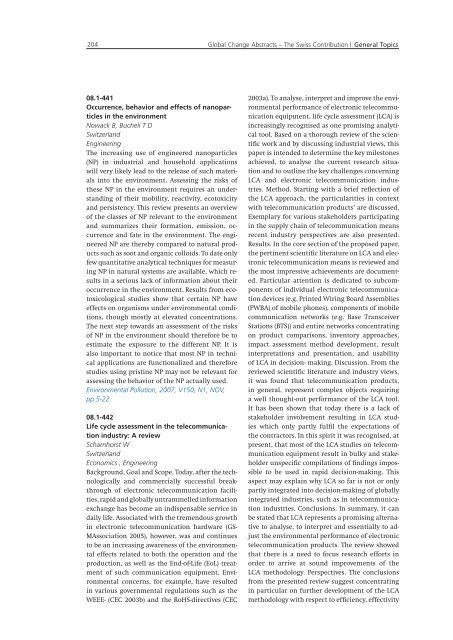Global Change Abstracts The Swiss Contribution - SCNAT
Global Change Abstracts The Swiss Contribution - SCNAT
Global Change Abstracts The Swiss Contribution - SCNAT
You also want an ePaper? Increase the reach of your titles
YUMPU automatically turns print PDFs into web optimized ePapers that Google loves.
204 <strong>Global</strong> <strong>Change</strong> <strong>Abstracts</strong> – <strong>The</strong> <strong>Swiss</strong> <strong>Contribution</strong> | General Topics<br />
08.1-441<br />
Occurrence, behavior and effects of nanoparticles<br />
in the environment<br />
Nowack B, Bucheli T D<br />
Switzerland<br />
Engineering<br />
<strong>The</strong> increasing use of engineered nanoparticles<br />
(NP) in industrial and household applications<br />
will very likely lead to the release of such materials<br />
into the environment. Assessing the risks of<br />
these NP in the environment requires an understanding<br />
of their mobility, reactivity, ecotoxicity<br />
and persistency. This review presents an overview<br />
of the classes of NP relevant to the environment<br />
and summarizes their formation, emission, occurrence<br />
and fate in the environment. <strong>The</strong> engineered<br />
NP are thereby compared to natural products<br />
such as soot and organic colloids. To date only<br />
few quantitative analytical techniques for measuring<br />
NP in natural systems are available, which results<br />
in a serious lack of information about their<br />
occurrence in the environment. Results from ecotoxicological<br />
studies show that certain NP have<br />
effects on organisms under environmental conditions,<br />
though mostly at elevated concentrations.<br />
<strong>The</strong> next step towards an assessment of the risks<br />
of NP in the environment should therefore be to<br />
estimate the exposure to the different NP. It is<br />
also important to notice that most NP in technical<br />
applications are functionalized and therefore<br />
studies using pristine NP may not be relevant for<br />
assessing the behavior of the NP actually used.<br />
Environmental Pollution, 2007, V150, N1, NOV,<br />
pp 5-22.<br />
08.1-442<br />
Life cycle assessment in the telecommunication<br />
industry: A review<br />
Scharnhorst W<br />
Switzerland<br />
Economics , Engineering<br />
Background, Goal and Scope. Today, after the technologically<br />
and commercially successful breakthrough<br />
of electronic telecommunication facilities,<br />
rapid and globally untrammelled information<br />
exchange has become an indispensable service in<br />
daily life. Associated with the tremendous growth<br />
in electronic telecommunication hardware (GS-<br />
MAssociation 2005), however, was and continues<br />
to be an increasing awareness of the environmental<br />
effects related to both the operation and the<br />
production, as well as the End-of-Life (EoL) treatment<br />
of such communication equipment. Environmental<br />
concerns, for example, have resulted<br />
in various governmental regulations such as the<br />
WEEE- (CEC 2003b) and the RoHS-directives (CEC<br />
2003a). To analyse, interpret and improve the environmental<br />
performance of electronic telecommunication<br />
equipment, life cycle assessment (LCA) is<br />
increasingly recognised as one promising analytical<br />
tool. Based on a thorough review of the scientific<br />
work and by discussing industrial views, this<br />
paper is intended to determine the key milestones<br />
achieved, to analyse the current research situation<br />
and to outline the key challenges concerning<br />
LCA and electronic telecommunication industries.<br />
Method. Starting with a brief reflection of<br />
the LCA approach, the particularities in context<br />
with telecommunication products’ are discussed.<br />
Exemplary for various stakeholders participating<br />
in the supply chain of telecommunication means<br />
recent industry perspectives are also presented.<br />
Results. In the core section of the proposed paper,<br />
the pertinent scientific literature on LCA and electronic<br />
telecommunication means is reviewed and<br />
the most impressive achievements are documented.<br />
Particular attention is dedicated to subcomponents<br />
of individual electronic telecommunication<br />
devices (e.g. Printed Wiring Board Assemblies<br />
(PWBA) of mobile phones), components of mobile<br />
communication networks (e.g. Base Transceiver<br />
Stations (BTS)) and entire networks concentrating<br />
on product comparisons, inventory approaches,<br />
impact assessment method development, result<br />
interpretations and presentation, and usability<br />
of LCA in decision- making. Discussion. From the<br />
reviewed scientific literature and industry views,<br />
it was found that telecommunication products,<br />
in general, represent complex objects requiring<br />
a well thought-out performance of the LCA tool.<br />
It has been shown that today there is a lack of<br />
stakeholder involvement resulting in LCA studies<br />
which only partly fulfil the expectations of<br />
the contractors. In this spirit it was recognised, at<br />
present, that most of the LCA studies on telecommunication<br />
equipment result in bulky and stakeholder<br />
unspecific compilations of findings impossible<br />
to be used in rapid decision-making. This<br />
aspect may explain why LCA so far is not or only<br />
partly integrated into decision-making of globally<br />
integrated industries, such as in telecommunication<br />
industries. Conclusions. In summary, it can<br />
be stated that LCA represents a promising alternative<br />
to analyse, to interpret and essentially to adjust<br />
the environmental performance of electronic<br />
telecommunication products. <strong>The</strong> review showed<br />
that there is a need to focus research efforts in<br />
order to arrive at sound improvements of the<br />
LCA methodology. Perspectives. <strong>The</strong> conclusions<br />
from the presented review suggest concentrating<br />
in particular on further development of the LCA<br />
methodology with respect to efficiency, effectivity

















